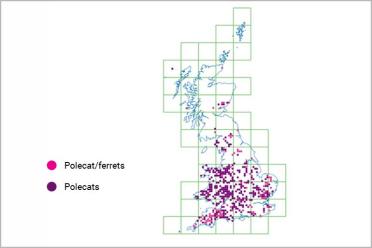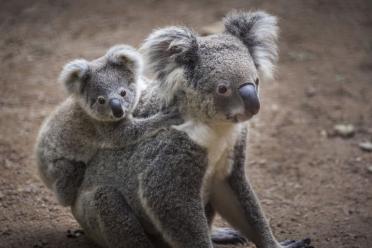Polecats and ferrets and koalas - oh, my!
How do you spot a polecat-ferret hybrid, and what can we learn about disease immunity from baby koalas?
From the genetics of domestication to conservation genomics and searching for new elements associated with disease, there’s lots to be discovered!
In this modern era of genomics, it’s possible to explore the essence of life throughout abundant species. Sequencing, assembling and mining non-human genomes can shed important light on a plethora of attributes that not only apply to the world around us but can often relate to studies of ourselves.
Within the genomes of mammal species there are all sorts of clues about evolution, conservation, domestication and disease - and where better to start than with Dr Graham Etherington of the Di Palma Group’s research on polecats, ferrets, and koalas? Oh, my!
With the domestication of ferrets came their inevitable escape from captivity, and there are feral ferrets living in various pockets throughout the United Kingdom.
Feralisation happens with various species, including house cats. This can pose somewhat of a hazard to native, distinct species - an example being the genetic amalgamation of the Scottish wildcat with some of our feral, formerly domestic companions.
The ancestor of the domestic ferret, the European polecat, is native to the UK but was almost driven to extinction from British shores after hunting for fur. Despite this, from a stronghold in Wales, these animals have since spread throughout swathes of the country, with populations established as far east as East Anglia and north through Cumbria and into Dumfriesshire.
Thus, we have native polecats and feral ferrets roaming through common territory - which presents an opportunity.

For the ferrets and polecats, this is breeding. For scientists, an extremely useful tool with which to study the process of domestication. As ferrets derived from European polecats (which cluster more closely together than they do with their American cousin the black-footed ferret), hybrids of the two are very useful animals to investigate in terms of the genetics of domestication.
Not only do we have the start point (pure polecats) and end point (domestic ferrets) but we have plenty in-between that could be 50:50, 25:75 or any ratio ranging through 1 to 100.
Such studies might not seem very important - but then we must consider that we have been domesticating some crucial species (in terms of human survival) for thousands of years.
Our cows, horses, pigs, and sheep have been massively domesticated, as well as our wheat, corn, potatoes and tomatoes.
Better understanding the processes behind domestication, using information from animals such as ferrets and dogs, can help us unlock the secrets behind other domestication events, which could help us to improve understanding of our agriculturally important domesticated species going forwards.
Black-footed ferrets represent another closely related mustelid with a lot to teach us.
These incredibly cute, but no less vicious, prairie dog killers were on the brink of extinction due to susceptibility to disease and persecution of their prairie dog prey. The population eventually dropped to only seven black-footed ferrets, all of which were used in a captive breeding programme.
Reintroduction of the ferrets has been largely successful in several states of the USA - but repopulation from such a tiny number comes with problems.
One such problem is the hugely restrictive genetic bottleneck that comes with such a diminished population. The genetic diversity previously present in abundant populations has largely been lost, which means that modern populations are heavily inbred.
Inbreeding and low genetic diversity present many problems. We can see in domestic dogs how this occurs in terms of health and development, with various breeds more prone to tumors, heart complications and other injurious effects.
In the wild, disease resistance is also a huge issue. Black-footed ferrets are no stranger to this, with current populations suffering severely from diseases such as canine distemper and sylvatic plague.
Genetic diversity usually presents individuals, or groups, with increased resistance to certain diseases. However, this can be lost through genetic bottlenecks, which is evidenced by the black-footed ferrets.
In a world in which more and more species are threatened with extinction, or near extinction, primarily due to human activity, it is important that we can understand the genetics associated with this.
It’s not only black-footed ferrets but pink pigeons, rhinos and more. Some species seem to cope remarkably well with low genetic diversity - cheetahs for example - but for others, this presents a threat to survival. Studying black-footed ferrets, along with other species on the brink, therefore presents a very useful tool in conservation biology.

As with their kangaroo cousins, the koalas come equipped with a pouch. Though, their young joeys are not as well equipped with a fully functional immune system.
Born very underdeveloped, these brave young koalas must thrive and survive in a damp, dark, sweaty pouch, laden with bacteria and fungi that might threaten the life of an immunocompromised young mammal.
However, koala joeys seem to cope just fine (notwithstanding other complications discussed below). So what can we learn from our marsupial cousins down-under?
Well, what if, in the milk of the mother koala, or indeed the pouch, there is some sort of useful immune-related protein that helps the joeys survive the microbial soup within? We know that breast milk helps human babies navigate around infections with useful antibodies. Perhaps, in koalas, there is something even stronger?
This is one thrust of research into koala genomics. Mining the koala genome for elements associated with disease might present us with novel drugs to help immunocompromised patients recover from, or withstand, infections.
However, the koalas aren’t always so lucky when it comes to disease resistance.
Their largely diminishing populations in the east of Australia, as well as suffering from human-prescribed habitat loss, are extremely prone to chlamydia - which often can cause death.
If this weren’t annoying enough, koalas also suffer from the koala retrovirus (KoRV) - a virus similar to HIV in humans, except it is even more insidious - being endogenous - i.e. it establishes itself in the koala genome and is passed on to the young.
Essentially, KoRV leads to AIDS-like KIDS (koala immune deficiency syndrome), which leaves young koalas prone to infection and cancers. Thus, the sweaty pouch in which the joeys must survive their early days and weeks becomes yet more of a hazardous environment.
With a genome of a similar size to our own (about 3.5 billion nucleotides long), koalas, therefore present a great opportunity to study the effects of disease, and a great comparison to how humans (and other mammals) tolerate and respond to infections such as chlamydia.
With the rise of multi-drug-resistant infections including gonorrhoea, chlamydia and syphilis, this sort of research is increasingly relevant and important. Furthermore, study of endogenous retroviruses is very interesting, as at least 42 human genetic elements are derived from historic retroviruses.

There is a tremendous amount we can learn from non-human species, especially our close mammalian relatives.
We develop in a similar way and we suffer from similar diseases, which means that we can learn a great deal about our own biology and perhaps use this knowledge to better human health.
We can use knowledge gleaned from feral animals to help us better understand the processes behind domestication of our economically important farmed species.
Furthermore, and perhaps more importantly, an increased understanding of the genetic threats that various organisms are facing worldwide might help us to save species from the brink.
Without preserving and maintaining biodiversity, from individual species to whole ecosystems, we won’t be around much longer.